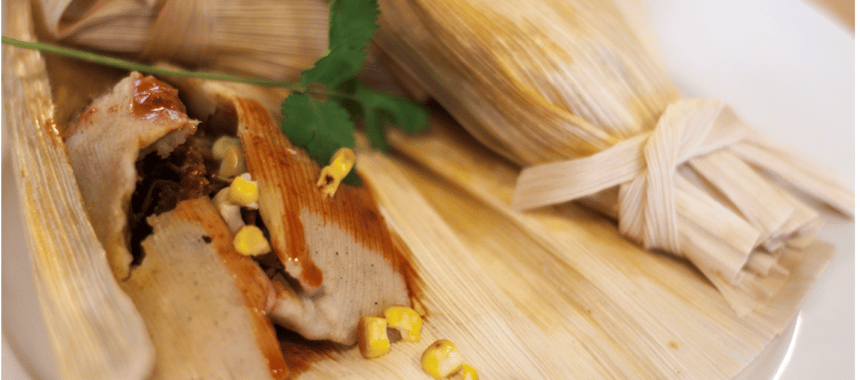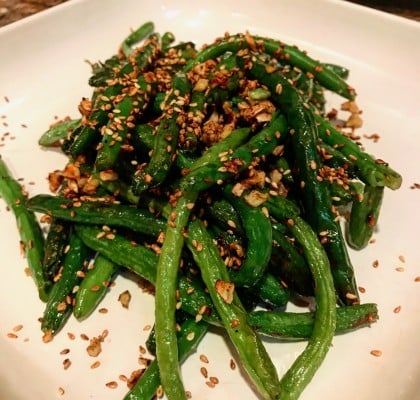I have a lot of vegetarian friends. When they find out I love to cook, I make a real good attempt to transform some of my recipes to vegetarian (sometimes VEGAN!) for them (sharing recipes or feeding them). But when these plant-based friends find out I make tamales, they nearly demand I make them a vegetarian version. It’s super easy to do so (as always, it just takes time – a labor and investment of love).
But what I have failed to do is put this vegetarian tamale version up on this blog. So here we are. Please note, you can get creative with vegetarian stuffing options, beyond cheese-only, although cheese-only sounds great right now. We won’t be diving into the “sweet tamale with a raisin” world in this recipe.
Stuffing ideas:
- Sauteed mushrooms, maybe using a bit of thyme as you sautee to infuse more earthy goodness!
- Potatoes (small diced & partially cooked, yukon works great)
- Sweet potato (small diced & partially cooked) and black beans
- Corn kernels – really most veggies that can be small-diced, make great additions to the cheese. Or, you could insert a single green olive (or whatever color you prefer) onto the bed of cheese and masa, like they are nearly obligated to do in Mexico.
Consider the olive (just for a moment)I love olives. Have I mentioned this? With it’s salty, fatty, and a little bit of bitterness, the olive is a mainstay for a tamale insert. And although I’m not Catholic (but have many beloved friends who are), I am told that the olive represents the Christ child waiting to be born — as he is every year at Christmas. Olive = Jesus. 🙂 And I suppose from a different vantage point, the tamal (single tamale) could also represent any person who carries seeds for future hope, growth and creativity within themselves. This olive could also be seen as the fertility of the fields and the bounty of the harvest. (Yes, the olive came from Europe, so we can also contemplate history, conquistadors, and the strength and spirit of the first nation peoples) Oh what a single olive can inspire.
Sure, that’s all super deep, symbolic and historical. That’s how the tamale rolls. Super deep and then: let’s get goofy and get down to business. We want tamales.
Vegetarian* Tamales
Highly recommended to use a scale and go with the gram measurements given. But not mandatory!
- Dried corn husks, 1 package, more or less (anywhere from 30-60 large husks)
- 4 1/2 c (560 g) Maseca corn flour mix (gluten free)
- 1 tbsp (12 g) Kosher salt
- 2 tsp (9 g) baking powder
- 3 1/2 – 4 c (870 g) vegetable stock, divided (we prefer soy-free, low sodium); if using cups, begin with the 3 1/2 cups, adding more if masa is still too dry
- 1 c (325 g) butter
- 2 c (166 g) shredded cheese (mozzarella, monterey jack, or 1-2 balls of oaxaca cheese that can easily be torn off into strips
- Vegetable filling of choice, pre-cooked, as described in the intro, 1-2 cups, optional
- Toppings, such as salsa, cotija, sour cream, cilantro, lime wedges, all optional
Step 1 (1 hour)
Completely submerge the entire package of husks in water (clean sink, large bowl, etc) and let soak for about 1 hour in cool water, or 30 minutes if adding to just-boiled water.
There are more husks than you’ll need, but it’s good to have extras on hand.
Step 2 (5 min)
In a large bowl combine masa, salt, and baking powder. Add the vegetable stock gradually in 1/3’s, using your hands to fully incorporate each 1/3 of the liquid—this will help take out any clumps. Once completely combined, cover with a damp towel or plastic wrap and set aside.
Step 3 (3-5 minutes)
Add the butter (or vegan alternative**) to the bowl of a stand mixer, or another large bowl. Using a paddle attachment, (or a simple hand mixer can work) whip the fat on medium-high speed, pausing occasionally to scrape the butter down the sides of the bowl. Whip until very smooth and full of air, about 4 minutes, though time will vary depending on how solid your butter is.
Step 4
With the stand mixer or hand mixer running on medium speed, add about a spoonful of masa mix at a time to the butter, mixing completely after each scoop before adding the next scoop, and of course occasionally stopping to scrape down the sides of the bowl. Once all the masa is added, mix on high to incorporate some more air, about a minute.
Step 5
Remove the husks onto a towel, or drain over a sink. Place a corn husk on your work surface (aka hand), with the tapered side facing away from you, the natural curve is up. Add about two rounded tablespoons of the masa mixture onto the husk, and spread the mixture in a thin, even layer over the lower two-thirds of the husk, leaving a half-inch border around the sides. (Don’t ruminate about the preciseness of these measurements… tamales are forgiving and will easily let you know if you’ve overfilled or didn’t add enough masa – just remember that you have cheese and veggies to add here too.)
Add a spoonful of your filling of choice to the center of the tamale. Example 1-2 pinches or strips of cheese. A spoonful of veggies, if using. Or add one glorious olive (as described in the intro). You could also include extras like cotija and green onion on top of all this. Or none of the above. You do you. 🙂
Time to fold by bringing the two long edges of the husk together, pinching the dough together to seal. Fold the tamale lengthwise to create a seam. Place the tamale seam-side down on the table, and tuck the tapered end of the husk underneath, the edge of the masa is where you do this. Use a small torn off piece of husk (from a different husk) and use it as a tie for the tucked end to the tamale. A knot will do as it easily slips off. 🙂
Grab some friends or family for this next part. Repeat all the above tamale filling and rolling and tying, with the remaining tamales. This is where the labor of love kicks into high gear. If “quality time” and/or “acts of service” are your love languages, now is your time to shine.
*You can stop right here and freeze the tamales if you’d like to steam them on another day. Or you can freeze after steaming (instructions below).
Step 6
Fit a tamale pot (or a large pot) with a steamer insert and fill the bottom with water, making sure the water does not cover the bottom of the steamer. Stand the tamales with the open end upright into the steamer insert, stacking without overfilling if fine. If you have extra space, add empty husks to help the tamales stay upright. Cover the pot with a lid.
Bring the water to simmer and steam the tamales, covered, for about 1 hour to 1 hour 30 minutes. KEEP CHECKING THE WATER. Check the water level every 15-20 minutes to make sure it hasn’t all evaporated. Add boiling water as needed.
Carefully remove the tamales with tongs out a few minutes before serving, and allow to cool and set slightly.
Step 7
Unwrap and serve – or let your guests do this! Just tell them to use caution as the steam escapes
Toppings, such as salsa, cotija, sour cream, herbs, lime wedges, optional, as needed
Unfold the corn husk, give the masa a light mash with the back of a fork and top the tamale with your choice: salsa verde (make our “Thank God for the Green Sauce” recipe found here), cotija, fresh herbs, hot sauce, avocados. Let’s celebrate the earth and each other!
*Prepping tamales ahead of time works out great – freeze them unsteamed and then steam according to the directions, perhaps adding 5 more minutes to the steam time as directed. If you do end up cooking them, allow the tamales to cool, then add them to a freezer-safe container, and reheat in the microwave wrapped in a towel for a minute (more or less time depending on the thickness).
**For vegan tamales, you’ll need to replace the butter and omit the cheese; we haven’t tested with vegetable shortening/coconut oil, nor have we tested vegan cheese, but do some research and give it a shot if that is something worth doing for you!
***Masa, with the inclusion of baking powder, adapted from Chefsteps tamale recipe. Great idea!





Pingback: Fall Food & Cooking Playlist - CollabFitness + Yoga